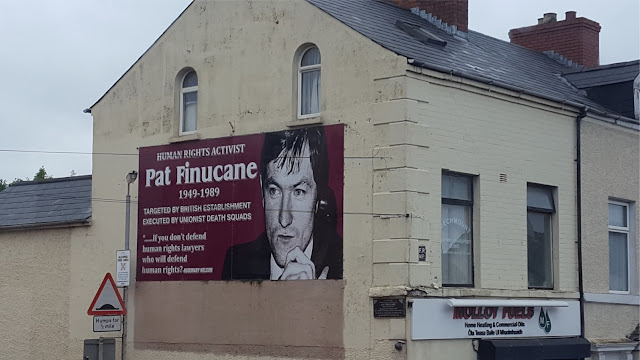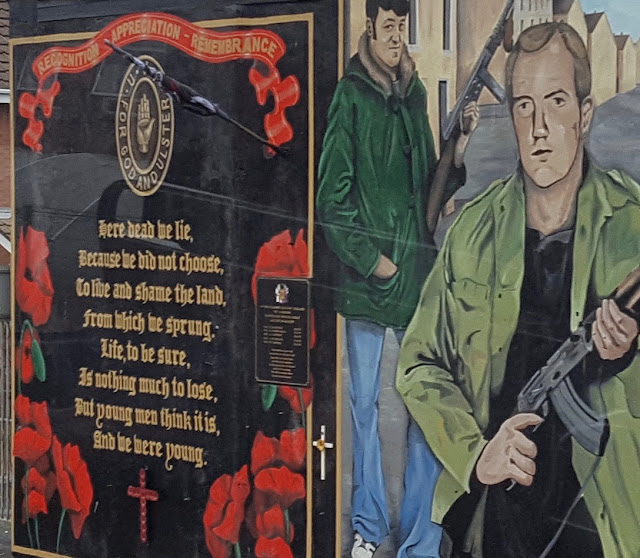I have wanted to do a blog on Belfast in Northern Ireland since we were there last fall. How to explain what my photos meant kept eluding me. For better or worse, here it is.
 |
| Belfast, Northern Ireland |
Belfast, in Northern Ireland, is one of the most exciting cities we have visited. It is the largest city in Northern Ireland and the second largest city on the island of Ireland. In the 1800s, it was the biggest producer of linen in the world. Its shipyard was the most productive in the world, building ships like the Titanic in 1922. There is a Titanic museum in Belfast, with each wing the size and shape of the bow of the Titanic.
Understanding Belfast requires some bare-bones history, or none of it makes sense. The Norman invasion of Ireland, which began in 1169, started 800 years of direct English rule of Ireland. In the early 1500s, Henry VIII began the change from a light ruling hand to a heavy, oppressive one. Protestants ruled. Catholics were called "barbarians" to justify their horrible treatment. The British army crushed periodic uprisings by the Irish. Thousands of English and Scottish Protestants were brought to Ireland in the 1500s and given the best land, displacing the former Irish owners. The 1600s were bloody, with half of the Irish population killed in years of fighting. The Penal Laws diminished Catholics' right to own land and prohibited Catholics from purchasing land from a Protestant. When a Catholic landowner died, he was forced to divide his land among all his sons unless the oldest son converted to Protestantism. This led to the ever-decreasing land ownership of Irish families over hundreds of years, as each son had to pass and divide his land onto his sons until the average family had subsistence farms that could not provide enough food to feed their children. Catholics were denied any political power and were prohibited by law from being members of the Irish Parliament.
The descendants of Protestants who took land away from the Irish in the 1500s have been in Northern Ireland longer than Europeans in the US. After nearly 500 years of living in Ireland, they consider themselves Protestant Irish and are unwilling to give their land back to the Catholic Irish. In the US, we took land away from the Indians less than 200 years ago, and we are not willing to give it back, so I guess I can understand their point.
In the 1900s, in Belfast, working-class areas were predominantly defined by religion, either Protestant or Catholic, with little integration. The industrial jobs in the shipyards and industries throughout the city were generally divided into either Catholic or Protestant workforces. Sports teams, housing estates, jobs, and all elements of daily life were all either Catholic or Protestant, with few areas naturally being mixed.
Tensions rose in the early 1900s until Easter 1916, a group of Irish separatists rebelled against the British, beginning the Irish War of Independence. The War of Independence cost up to 500 lives in Belfast, the bloodiest sectarian strife in the city until The Troubles of the late 1960s.
In 1920, Ireland was partitioned to end the war. Six counties in the north of Ireland remained part of Great Britain and became Northern Ireland. The rest of the island became the Republic of Ireland. This settlement divided the Irish, leading to the 1920-1924 Irish Civil War between those who supported the settlement and those who refused to accept the division of Ireland.
Belfast has been the capital of Northern Ireland since its establishment in 1921 following the Government of Ireland Act of 1920. The Protestant majority in Northern Ireland wanted to clarify that Northern Ireland was a Protestant State. Catholics were openly discriminated against, leading to episodes of sectarian conflict between its Catholic and Protestant populations. These opposing groups in this conflict are now often termed republican and loyalist, respectively, although they are also loosely referred to as 'nationalist' and 'unionist.' The most recent example of this conflict was The Troubles – a civil conflict that raged from around 1969 to 1998. Belfast saw some of the worst of The Troubles in Northern Ireland, particularly in the 1970s, with rival paramilitary groups formed on both sides. Bombing, assassination, and street violence formed a backdrop to life throughout The Troubles.
The Provisional IRA detonated 22 bombs within the confines of Belfast city center in 1972, on what is known as "Bloody Friday," killing eleven people. Loyalist paramilitaries, including the Ulster Volunteer Force (UVF) and the Ulster Defense Association (UDA), claimed that the killings they carried out were retaliation for the IRA campaign. Most of their victims were Catholics with no links to the Provisional IRA. A particularly notorious group based on Shankill Road in the mid-1970s became known as the Shankill Butchers. Over 1,600 people were killed in political violence in the city between 1969 and 2001.
The city suffered greatly during The Troubles and was once considered in the 1970s and 1980s one of the world's most dangerous cities. Guides we talked to told us of going through 20 checkpoints to get into downtown Belfast during The Troubles. Since the 21st century, the city has undergone a sustained period of calm, free from the intense political violence of former years, and has seen substantial economic and commercial growth. Sporadic violent events continue, although not supported by the previous antagonists who reached a political agreement in 1998.
Hopefully, this brief history will help you understand what these photos show.
Downtown Belfast looks like any other industrial city center. Gone are the military checkpoints and the armed soldiers. We took a tour bus ride around the city because it is only in the sectarian neighborhoods that you see what makes Belfast unique. There may not be open violence now, but the conflict has not been forgotten. Murals decorate many buildings. You see this mural as you enter one of the Protestant neighborhoods.
The color orange identifies the Protestant Unionists. The Catholic Nationalists are identified by green. The conflict between Protestants and Catholics has little to do with religious differences and much with power. The Protestants are the majority in industrialized Northern Ireland. They would be a small minority if incorporated into the rural Republic of Ireland. They could only maintain their power by staying united with Great Britain.




Post a Comment